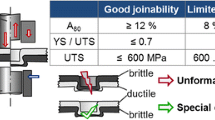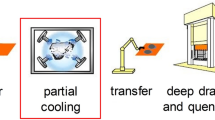Abstract
New requirements from the automotive industry regarding light weight design request the realization of structural parts with maximum strength over 1,000 MPa. On the other hand, demands concerning part complexity, function integration and part quality become higher and higher. The press hardening technology of boron-manganese alloyed steel for blank based part applications represent the state of the art. Typical applications are reinforcement parts in crash relevant car body structures. The consequently using of such parts allows to fulfil the requests of current and future cars regarding crash performance at acceptable structural weights. Beside press hardening parts also hydroformed profiles enable a high potential for applications in structural car body elements with high loads. By this, hydroforming of tubes and blanks at room temperature represents also the state of the art for several applications in car body structures or exhaust systems, but also for special applications outside the car industry. These parts are mainly made from materials such as steel, high-strength steel, stainless steel and aluminium. Originating from increased demands for hydroformed parts regarding maximum strength and complexity the limits of conventional hydroforming processes are reached. The use of temperature as a process parameter in hydroforming offers the chance to increase the application field of this innovative technology. The potential of this strategy was proven; complex car body parts of aluminium and magnesium were realized at elevated temperatures. However, today available fluids can only be used up to 300°C because of the limited thermal resistance of the available fluids. Gaseous media (e.g. nitrogen) offer the chance to use the potential of temperature-supported hydroforming also in steel forming. Consequently, temperatures up to 1,000°C can be provided. In analogy to hot stamping processes for blanks, it is also possible to combine the gas forming process with a special heat treatment and to realize closed structural parts with highest strength in anthology to applications of hydroformed car body structures, such as A-pillars (BMW, Volvo, Opel), roof rails (Audi), cross members (BMW), crash cans (Volvo) or sill reinforcement parts (Audi, Volvo), in serial production.








Similar content being viewed by others
References
Neugebauer R, Bräunlich H (1999) Lightweight construction by innovative forming technologies. In: Proceedings of the 6th international conference on technology of plasticity “advanced technology of plasticity 1999”. Nuremberg 24–29 September 1999, pp 1119–1128
Klein B (1994) Leichtbau-Konstruktion, Berechnungsgrundlagen und Gestaltung. Friedr. Viehweg & Sohn Verlagsgesellschaft mbH, Braunschweig/Wiesbaden
Schmidt W, Puri W (2000) Systematische entwicklung gewichtsoptimierter bauteile. Tagungsband zum 11. Symposium „Design for X”. Schnaittach, 12–13 October 2000, pp 37–40
Geiger M, Hofmann A (1999) Neue Entwicklungen in der Aluminiumblechumformung, Erlangen. Das Umformen von Aluminium im Automobilbau. Praxis Forum, Bad Nauheim, pp 111–131
Hoffmann H, Toussaint A (1999) Strategies and future developments in the manufacturing process of lightweight car bodies. Advanced technology of plasticity. Bd. II. Springer, Berlin, pp 1129–1140
Drewes E-J, Wagner S, Welsh F (1999) Karosseriegestaltung unter Berücksichtigung moderner Stahlwerkstoffe und neuer Fertigungsverfahren. In: FTK’97 Innovation durch Technik und Organisation. Springer, Berlin, pp 96–106
Novotny S (2002) Innenhochdruck-umformen von blechen aus aluminium- und magnesiumlegierungen bei erhöhter temperatur. Dissertation, Technische Fakultät der Friedrich-Alexander-Universität Erlangen Nürnberg
Author information
Authors and Affiliations
Corresponding author
Rights and permissions
About this article
Cite this article
Neugebauer, R., Schieck, F. Active media-based form hardening of tubes and profiles. Prod. Eng. Res. Devel. 4, 385–390 (2010). https://doi.org/10.1007/s11740-010-0258-x
Received:
Accepted:
Published:
Issue Date:
DOI: https://doi.org/10.1007/s11740-010-0258-x




